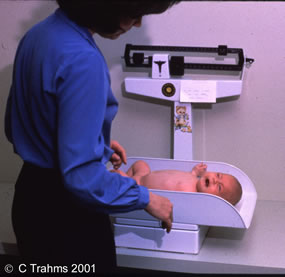
Weight
Weight is used to make many important decisions about a child's nutritional status and clinical care plan. It is imperative that accurate weight measurements are made.
It is more important to have an accurate bi-annual weight than an inaccurate monthly weight. Children under the age of 2 years should be measured on a pan- or bucket seat-type scale.| Equipment: Use a calibrated beam balance scale or digital scale with "strain gauge" mechanism that is accurate to 10 grams or 1/4 ounce. A clean cloth or pad is often used in the "bucket" of the scale. The scale should be calibrated before each use to reflect the weight of the cloth or pad. |
 |
|
|
Child and Positioning: |
||
| Measurement: Measure the infant's weight to the nearest 10 grams or 1/4 ounce. Record any conditions that might have interfered with an accurate weight (e.g., infant was moving). |